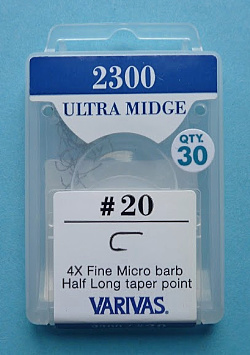Upstream Worm Hooks
Smaller is Better
The old masters could not agree on the best upstream worm hooks. It's highly unlikely we'll all agree now. My view is that smaller is better.
Before WC Stewart's The Practical Angler, published in 1857, the universal practice was to use one hook and to thread the worm onto the hook, past the end of the hook and up onto the gut "tippet". The hook point was brought out of the worm with perhaps a third of the worm free to wriggle. Even then, though, they didn't agree whether to start at the head and leave the tail free or start at the tail and leave the head free.
The only thing about which they agreed was that one should not hook the worm over and over again so that it was all bunched up on the hook and there was nothing left to wriggle. (Which is how I see almost everone on a worm fishing or micro fishing video hook their worms. I have said before and I'll say again, owning a GoPro does not make one an expert.)
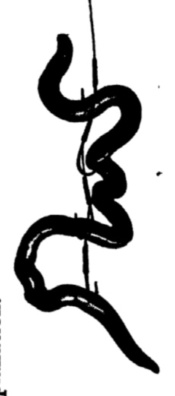 Stewart Tackle with four hooks
Stewart Tackle with four hooksWC Stewart proposed using three or even four hooks. In his words "The advantages of this tackle are—that a trout can hardly take hold of the worm at all without having one of the hooks in its mouth; that the worm lives much longer, and being free to wriggle itself into any shape, is more natural looking and consequently enticing; and lastly, that it is much more easily baited, particularly if the worms are fresh. Its disadvantages are—that it is more difficult to extricate from the trout's mouth; that it requires to be baited afresh every bite; and that the exposure of so many hooks is calculated to scare away some trout that would otherwise take the bait. But, upon the whole, the advantages preponderate considerably over the disadvantages, particularly when trout are biting shy."
HC Pennell's Fly Fishing and Worm Fishing for Salmon, Trout and Grayling was published in 1876. In it, he wrote "Mr. Stewart was the first to advocate a radical reform in the matter of trout worm-tackle. His change was to substitute three or four small hooks for the one large one. This plan, by which the hooks were quickly and lightly passed transversely through the worm instead of being, as it were, threaded through it, has the additional merit of keeping the bait alive much longer, as well as of enabling the fish to be struck almost at the instant of biting, instead of being allowed some uncertain period in which to fairly 'mouth,' or, as it happens in many cases, 'pouch' the worm."
I think "pouch" can be understood as "swallow."
After reviewing Stewart's advantages and disadvantages, Pennell goes further "I adopted a tackle consisting of only two hooks, and these a trifle larger and thicker in the wire, which, I found, whilst getting rid of the drawbacks, also combined one or two material improvements in other respects."
"The great advantages, in several points, of the four-hook tackle over the large single hook have been already explained. The advantages which I believe will be found to belong to the two-hook over the four-hook tackle are: (i) It is baited in less than half the time; (2) the worm lives much longer; (3) its appearance is more natural; (4) the hooks are less conspicuous; (5) they are very quickly 'disgorged,' and (6) the tackle is more easily made."
"In hooking and holding power I do not think that there is any appreciable difference."
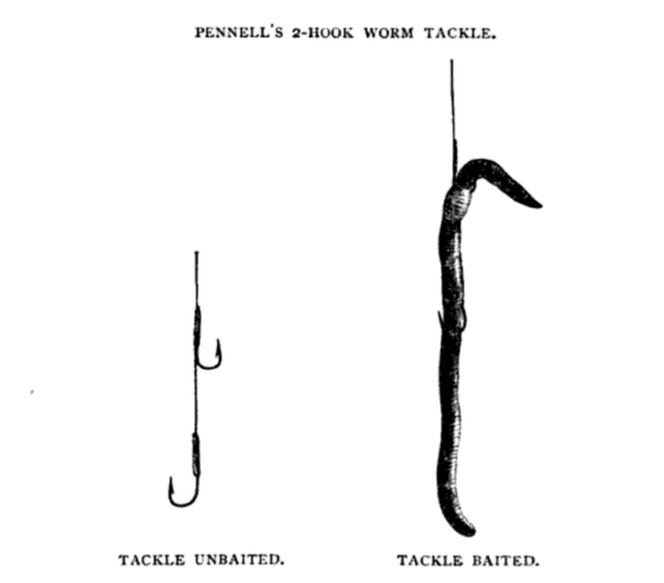
I have not tried either the Stewart Tackle or the Pennell Tackle with worms. The illustrations in both of the books show worms that are much larger than I would use. I can certainly understand why they would want to use more than one hook for a worm of that size. I think it would be highly likely that with only one hook many, if not most trout that took the worm would miss the hook. You would have to either strike immediately and miss many of the fish or wait until you're sure the hook is in his mouth - by which time it is likely to be in his stomach.
I have, however, used the concept of a Pennell rig with pink chenille, as I often missed fish that hit my Pink Chenille Worm version of the well-known San Juan Worm. To try to reduce the frequency of missed hits, I tied a second hook to the chenille. The chenille I used (Hareline Dubbin' Micro Ultra Chenille) was strong enough that I tied the rear hook to the chenille rather than to the front hook with a piece of mono.
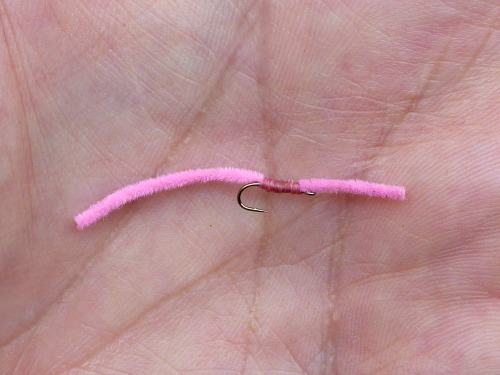 Pink Chenille Worm
Pink Chenille Worm(Daiichi 1110 size 26)
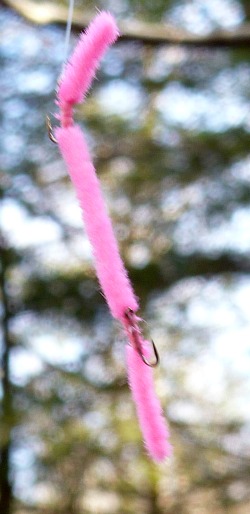 Pink Chenille Pennell
Pink Chenille PennellThe Pink Chenille Pennell rig did seem to reduce the percentage of missed hits. With a real worm, though, I haven't noticed a great number of missed hits even when using only one hook.
I think the main reason for that is the small size of the worms I use. I suspect that most of the people who fish with worms use either night crawlers, the "big red worms" or "trout worms" that are the standard bait shop worm, or the earthworms they did in the back yard. Instead of those, all of which I think are too large for trout fishing, I use only red wigglers (eisenia fetida). These are the "brandling" worms that most of the old masters mention (some very favorably, and some very unfavorably).
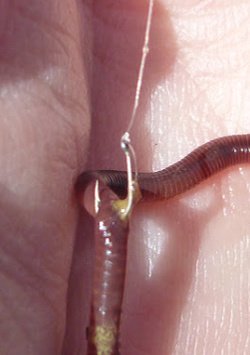 Red wiggler, size 30 hook
Red wiggler, size 30 hookRed wigglers are only about an inch and a half long. I have always hooked them once, crossways in about the middle of the worm. That way, there's only about 3/4" of worm on either side of the hook.
A trout seems to get the hook in its mouth most of the time. I do miss a few hits that cannot be attributed to tension on the line, and after a missed hit I occasionally notice half the worm is gone. However, in those cases, a cast back to the same spot generally results in another hit and a solid hook up.
I also generally use very small hooks. The largest I will use is a
20, and I have used hooks as small as a 30. I do think the 20 results in
fewer missed strikes - but the difference isn't great. With hooks much larger than a 20, like the 12 or 14 recommended by Harold Blaisdell, I have noticed many more missed strikes. I think the fish feel the hook, which is a second reason for the missed hits that he couldn't explain. (The first reason was tension on the line.)
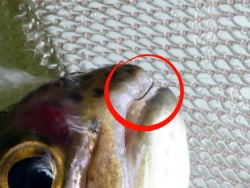 Varivas 2300 midge hook
Varivas 2300 midge hookSize 28
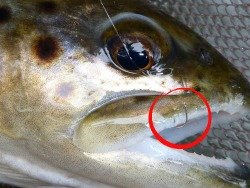 Varivas 2300 midge hook
Varivas 2300 midge hookSize 28
The reason I use small hooks is this: as far as I know, there are only two reasons why a trout would spit out a worm 1) it feels tension on the line, or 2) it feels the hook. By managing the sag in the line, I can detect a strike before there is tension on the line. Thus I can minimize the first reason. By using a very small hook, I can minimize the second reason.
On the day I fished with size 28 Varivas 2300 midge hooks and took the photos above I did miss a few fish, but I've missed a lot more fish when using larger hooks. I was quite pleasantly surprised at how well they hooked and how well they held. In no case did I "set the hook." When the line stopped I just tightened the line. If it was a rock it didn't move. If it was a fish it started to wiggle.
I learned the "no hook set" approach on the day I took the photo with the size 30 hook and the worm, above. I was trying the Japanese "Zero" subniche of keiryu fishing, which uses a very small hook, very light line, very little weight and a very soft rod in an attempt to add as close to nothing (zero) to the bait and achieve a perfectly natural drift. I was using 10X tippet, which breaks at 1.1 lb test. I broke the tippet on the first two hook sets. I then settled down, stopped "setting the hook," and started catching fish.
I have since settled on size 20 hooks. I think they are small enough that the fish don't notice them and they are easier to remove than the size 28 and 30 hooks. Even for the size 20 hooks, though, clamps will be necessary. A clamp with sharply pointed jaws, like the Dr. Slick Spring Creek Clamps works well.
Seriously, when using these small hooks, don't set the hook. Just tighten the line. Don't be tentative, but don't be forceful.
Upstream Worm Lines and Line Sag
Upstream Worm Hooks and Hooking
“The bitterness of poor quality remains long after the sweetness of low price is forgotten” - Benjamin Franklin
"Be sure in casting, that your fly fall first into the water, for if the line fall first, it scares or frightens the fish..." -
Col. Robert Venables 1662
As age slows my pace, I will become more like the heron.
Warning:
The hooks are sharp.
The coffee's hot.
The fish are slippery when wet.
Beware of the Dogma
What's in stock?
Suntech Tenkarakyo 40F Tenkara Rods
Suntech Kurenai II AR39F
Seiryu Rods
Coming Soon
Latest Pages
If you enjoy spin fishing or baitcasting please visit my sister site Finesse-Fishing.com.
